科技文本翻译
- 格式:ppt
- 大小:181.00 KB
- 文档页数:28
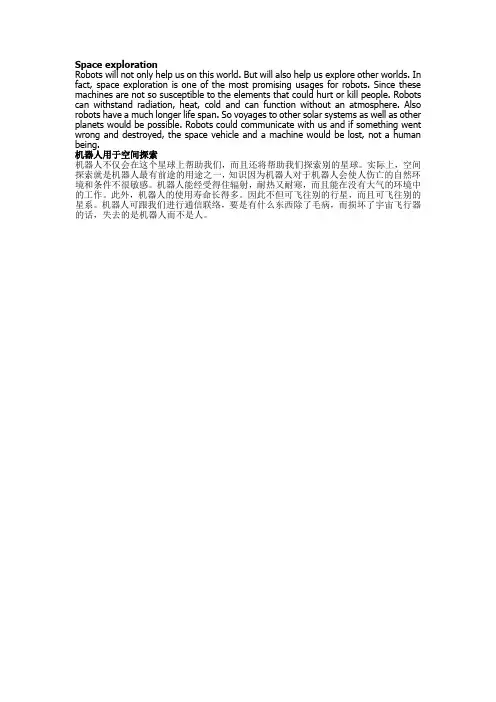
Space explorationRobots will not only help us on this world. But will also help us explore other worlds. In fact, space exploration is one of the most promising usages for robots. Since these machines are not so susceptible to the elements that could hurt or kill people. Robots can withstand radiation, heat, cold and can function without an atmosphere. Also robots have a much longer life span. So voyages to other solar systems as well as other planets would be possible. Robots could communicate with us and if something went wrong and destroyed, the space vehicle and a machine would be lost, not a human being.机器人用于空间探索机器人不仅会在这个星球上帮助我们,而且还将帮助我们探索别的星球。
实际上,空间探索就是机器人最有前途的用途之一,知识因为机器人对于机器人会使人伤亡的自然环境和条件不很敏感。
机器人能经受得住辐射,耐热又耐寒,而且能在没有大气的环境中的工作。
此外,机器人的使用寿命长得多。
因此不但可飞往别的行星,而且可飞往别的星系。
机器人可跟我们进行通信联络,要是有什么东西除了毛病,而损坏了宇宙飞行器的话,失去的是机器人而不是人。
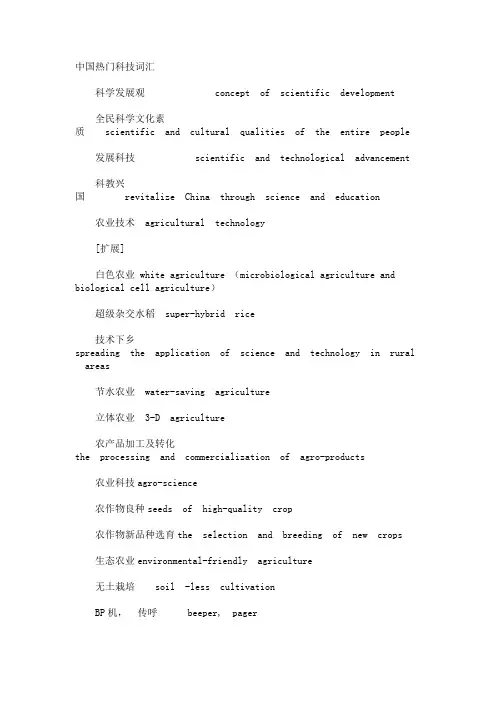
中国热门科技词汇科学发展观concept of scientific development全民科学文化素质scientific and cultural qualities of the entire people 发展科技scientific and technological advancement科教兴国revitalize China through science and education 农业技术agricultural technology[扩展]白色农业 white agriculture (microbiological agriculture and biological cell agriculture)超级杂交水稻super-hybrid rice技术下乡spreading the application of science and technology in rural areas节水农业water-saving agriculture立体农业3-D agriculture农产品加工及转化the processing and commercialization of agro-products 农业科技agro-science农作物良种seeds of high-quality crop农作物新品种选育the selection and breeding of new crops 生态农业environmental-friendly agriculture无土栽培soil -less cultivationBP机,传呼beeper, pager背投屏幕rear projection screen不明飞行物unidentified flying object (UFO)操作系统operating system产品科技含量technological element of a product创新innovation电话会议teleconference电话留言机answering machine对讲机talkie and walkie多媒体multimedia二期the second phase防抱死系统ABS (anti-lock braking system)孵化器incubator高产优质high yield and high quality高技术产业化apply high technology to production高科技板块high-tech sector高科技园high-tech park个人数字助理PDA (personal digital assistant)工业园区industrial park国家质量技术监督局the State Bureau of Quality and Technical Supervision 国家重点实验室national key laboratories火炬计划Torch Program (a plan to develop new and high technology)计算机中央处理器central processing unit(CPU)技术产权technology property right技术交底confide a technological secret to someone.技术密集产品technology-intensive product交叉学科interdisciplinary branch of science科技成果转化为生产力 transfer of scientific and technological achievements into productive forces科技含量technology content科技基础设施science and technology infrastructure科技是第一生产力Science and technology constitute a primary productive for ce科技体制改革reform of the science and technology management system科技与经济脱节science and technology are out of line from the economy科教兴国rejuvenate the country through science and education可持续发展战略strategy of sustainable development纳米nanometer三峡水利枢纽工程the key water control project at the Three Gorges on the Yangtze River物种起源origin of species新兴学科new branch of science研究成果research results在孵企业incubated enterprises自动取款机automatic teller machine (ATM)自然科学与社会科学的交叉融合integration of natural and social sciencesIT 信息技术[扩展]信息港info port信息高地information highland信息高速公路information superhighway信息革命information revolution信息含量information content信息化informationization信息技术处理ITA - Information Technology Agreement 信息检索information retri办公自动化OA (Office Automation)笔记本电脑laptop / notebook / portable computer 电脑病毒computer virus电脑犯罪computer crime电子管理e-management电子货币e-currency电子商务e-business; e-commerce电子商务认证e-business certification电子邮件E-mail非对称数字用户环路ADSL (Asymmetrical Digital Subscriber Loop)高速宽带互联网high-speed broadband networks公告板BBS (bulletin board system)光盘杂志CD-ROM magazine广域网WAN (wide area net word)汉字处理软件Chinese character processing software黑客hacker计算机2000年问题Y2K problem计算机辅助教育CAI -computer assisted instruction计算机辅助设计CAD-computer assisted design计算机合成制造CAM-computer assisted manufacturing计算机中央处理器CPU - central processing unit超文本传送协议hypertext transfer protocol (HTTP)界面interface金融电子化computerized financial services局域网LAN - local area network互联网服务提供商ISP (Internet Service Provider)全球移动通信系统(全球通)global system for mobile communications (GSM)刻录机CD burner宽带接入broadband access宽带网broadband networks内联网、局域网(计算机)Intranet垃圾邮件junk mail千年问题、千年虫millennium bug; Y2K bug 人工智能AI - artificial intelligence人机交互human - computer interaction人机交互human-computer interaction虚拟人visual human虚拟网virtual net虚拟网virtual net虚拟现实virtual reality虚拟银行virtual bank因特网服务提供商ISP- internet service provider万维网World Wide Web(WWW)应用软件internet applications域名domain在线on line掌上电脑palm computer政府上网工程Government Online Project只读存储器read-only-memory (ROM)智能感知技术perceptive technology智能终端intelligent terminal中文信息处理系统Chinese information processing system数码科技digital technology高保真Hi-Fi (High Fidelity)高清晰度电视high definition TV (HDTV)光谷optical valley光通讯optical communication蓝光光盘Blue -ray Disc数码港cyber port数字地球digital globe数字蜂窝移动通信digital cellular mobile telecommunications三维电影three-dimensional movie三维动画three-dimensional animation[详析] “蓝光光盘”利用蓝色的激光束来刻录数据。
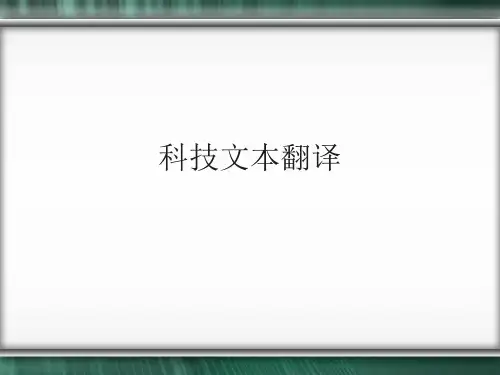
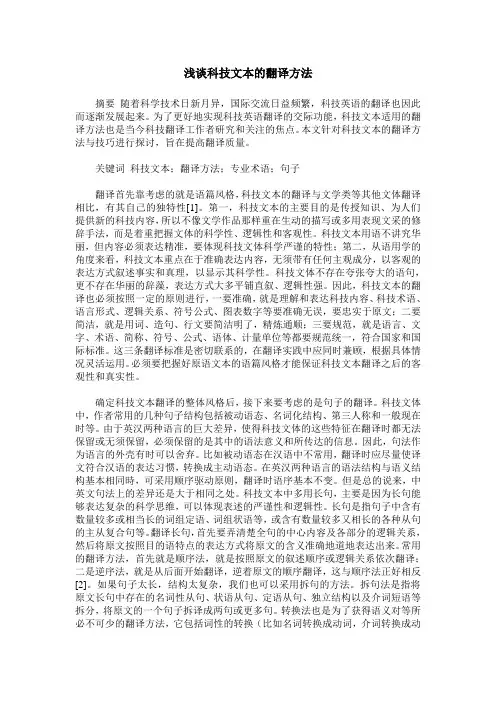
浅谈科技文本的翻译方法摘要随着科学技术日新月异,国际交流日益频繁,科技英语的翻译也因此而逐渐发展起来。
为了更好地实现科技英语翻译的交际功能,科技文本适用的翻译方法也是当今科技翻译工作者研究和关注的焦点。
本文针对科技文本的翻译方法与技巧进行探讨,旨在提高翻译质量。
关键词科技文本;翻译方法;专业术语;句子翻译首先靠考虑的就是语篇风格,科技文本的翻译与文学类等其他文体翻译相比,有其自己的独特性[1]。
第一,科技文本的主要目的是传授知识、为人们提供新的科技内容,所以不像文学作品那样重在生动的描写或多用表现文采的修辞手法,而是着重把握文体的科学性、逻辑性和客观性。
科技文本用语不讲究华丽,但内容必须表达精准,要体现科技文体科学严谨的特性;第二,从语用学的角度来看,科技文本重点在于准确表达内容,无须带有任何主观成分,以客观的表达方式叙述事实和真理,以显示其科学性。
科技文体不存在夸张夸大的语句,更不存在华丽的辞藻,表达方式大多平铺直叙、逻辑性强。
因此,科技文本的翻译也必须按照一定的原则进行,一要准确,就是理解和表达科技内容、科技术语、语言形式、逻辑关系、符号公式、图表数字等要准确无误,要忠实于原文;二要简洁,就是用词、造句、行文要简洁明了,精炼通顺;三要规范,就是语言、文字、术语、简称、符号、公式、语体、计量单位等都要规范统一,符合国家和国际标准。
这三条翻译标准是密切联系的,在翻译实践中应同时兼顾,根据具体情况灵活运用。
必须要把握好原语文本的语篇风格才能保证科技文本翻译之后的客观性和真实性。
确定科技文本翻译的整体风格后,接下来要考虑的是句子的翻译。
科技文体中,作者常用的几种句子结构包括被动语态、名词化结构、第三人称和一般现在时等。
由于英汉两种语言的巨大差异,使得科技文体的这些特征在翻译时都无法保留或无须保留,必须保留的是其中的语法意义和所传达的信息。
因此,句法作为语言的外壳有时可以舍弃。
比如被动语态在汉语中不常用,翻译时应尽量使译文符合汉语的表达习惯,转换成主动语态。
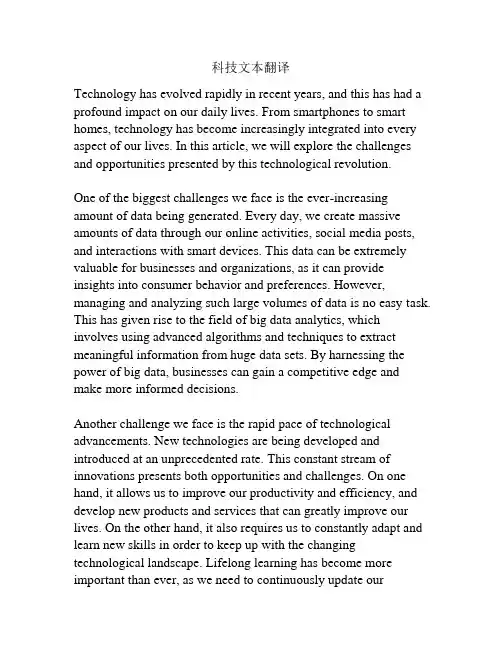
科技文本翻译Technology has evolved rapidly in recent years, and this has had a profound impact on our daily lives. From smartphones to smart homes, technology has become increasingly integrated into every aspect of our lives. In this article, we will explore the challenges and opportunities presented by this technological revolution.One of the biggest challenges we face is the ever-increasing amount of data being generated. Every day, we create massive amounts of data through our online activities, social media posts, and interactions with smart devices. This data can be extremely valuable for businesses and organizations, as it can provide insights into consumer behavior and preferences. However, managing and analyzing such large volumes of data is no easy task. This has given rise to the field of big data analytics, which involves using advanced algorithms and techniques to extract meaningful information from huge data sets. By harnessing the power of big data, businesses can gain a competitive edge and make more informed decisions.Another challenge we face is the rapid pace of technological advancements. New technologies are being developed and introduced at an unprecedented rate. This constant stream of innovations presents both opportunities and challenges. On one hand, it allows us to improve our productivity and efficiency, and develop new products and services that can greatly improve our lives. On the other hand, it also requires us to constantly adapt and learn new skills in order to keep up with the changing technological landscape. Lifelong learning has become more important than ever, as we need to continuously update ourknowledge and skills to stay relevant in the job market.The rise of artificial intelligence (AI) is another significant development in the field of technology. AI refers to the ability of machines to perform tasks that typically require human intelligence, such as language translation, image recognition, and decision-making. AI has the potential to revolutionize many industries, from healthcare to transportation to finance. However, it also raises concerns about job displacement and ethics. As machines become more capable of performing complex tasks, there is a fear that many jobs will become automated, leading to unemployment. Additionally, there are ethical questions surrounding AI, such as privacy and security concerns, as well as the potential for bias in decision-making algorithms.Despite these challenges, the technological revolution also presents immense opportunities. For example, advancements in renewable energy technologies can help us transition to a more sustainable future and reduce our reliance on fossil fuels. The Internet of Things (IoT), which refers to the network of interconnected devices and objects, has the potential to greatly improve our quality of life by enabling us to remotely control and monitor our homes, cars, and appliances. Virtual reality (VR) and augmented reality (AR) technologies are also opening up new possibilities in fields like gaming, entertainment, and education.In conclusion, the rapid advancement of technology has brought about many challenges, from managing big data to keeping pace with new innovations. However, it also presents numerous opportunities for improving our lives and solving global issues. Aswe navigate this technological revolution, it is important to strike a balance between embracing the benefits of technology and addressing the potential risks and concerns it brings. Only by doing so can we fully harness the power of technology to create a better future for all.。
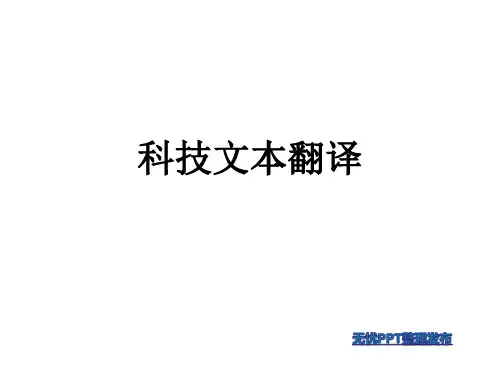
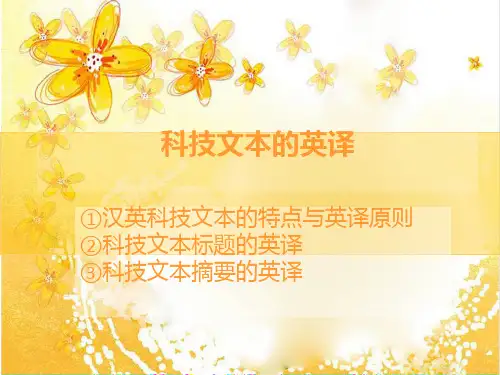
科技文本:科学专著、科学论文、实验报告、工程技术说明、科技文献、科普文献等•一、科技文本的特点与英译原则•(1)特点:用词严谨、准确,行文规范,逻辑严密,注重客观性,一般不带个人感情色彩。
已经从ESP中形成一个分支:EST.•(2)英译原则:• a.用词多样化,专业术语多,使用缩略语•purely technical words:•nuclear physics: proton(质子), neutron(中子), electron(电子), reactor(核反应堆), radioactivity(放射性).•semi-technical words:•fastener(建筑扣件), carrier(车床底座), gear switch(齿轮开关), clamp(夹钳), spade(铁铲).•non-technical words:•vapourate, minimize, reciprocate(报酬)科技文本缩略语的翻译:•(1)首字母缩写(acronym)•PC:Personal Computer•IDDD:International direct distance dialiry•DNA:dexoxybonucleic acid•DOS:Disc operation system•CPU:Central processing unit•Telecom:telecommunication•(2)拼凑法•Sicom:situation comedy Biorhythm:Biological rhythm Comsat:communication satellite Minicom:miniature computer •Psywar:psychological war Telecon:telephone conferenceb.语法特点:多用一般现在时;c.名词化现象,注意转换(汉语-动态语言,英语-静态语言)•eg.The house is under construction.•(The house is being constructed.)•例句:中国已经成功地发射了第一课实验通讯卫星。
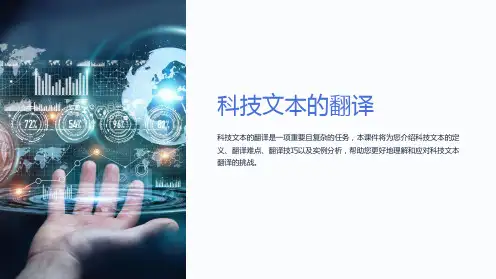
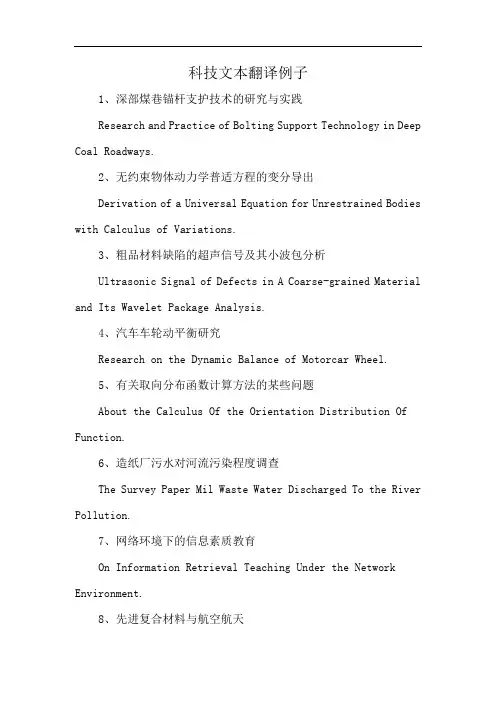
科技文本翻译例子1、深部煤巷锚杆支护技术的研究与实践Research and Practice of Bolting Support Technology in Deep Coal Roadways.2、无约束物体动力学普适方程的变分导出Derivation of a Universal Equation for Unrestrained Bodies with Calculus of Variations.3、粗品材料缺陷的超声信号及其小波包分析Ultrasonic Signal of Defects in A Coarse-grained Material and Its Wavelet Package Analysis.4、汽车车轮动平衡研究Research on the Dynamic Balance of Motorcar Wheel.5、有关取向分布函数计算方法的某些问题About the Calculus Of the Orientation Distribution Of Function.6、造纸厂污水对河流污染程度调查The Survey Paper Mil Waste Water Discharged To the River Pollution.7、网络环境下的信息素质教育On Information Retrieval Teaching Under the Network Environment.8、先进复合材料与航空航天Advanced Composite Materials and Aerospace Engineering.9、工艺中树脂固化温度与介电性能Temperature and Dielectric Properties of Resin during RTM Process RTM.10、使用毛细电泳仪根据泰勒扩散理论测量纳米粒子的扩散系数Determination of Nanoparticle Diffusion Coefficients by Taylor DispersionAnalysis Using A Capillary Electrophoresis Instrument.11、亚马孙雨林对干早的灵敏度Drought Sensitivity of the Amazon Rein-forest.。
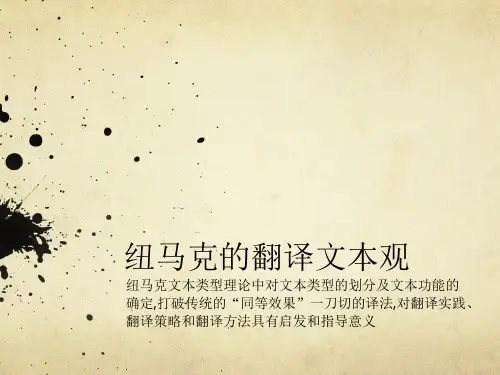

目的论视角下科技类文本的翻译随着全球化的深入和科技的飞速发展,科技类文本的翻译变得越来越重要。
科技类文本包括各种与技术、工程、计算机等领域相关的文献,如科学论文、技术手册、专利申请等。
这些文本的翻译不仅需要准确传达原文的含义,还需满足特定目的和受众的需求。
本文将从目的论视角探讨科技类文本的翻译。
目的论是翻译理论的一个重要分支,由德国学者汉斯·弗米尔于1978年提出。
目的论认为,翻译过程中译者的首要任务是确定翻译的目的,并根据目的选择合适的翻译策略。
在科技类文本的翻译中,目的通常是为了传达特定信息、解决问题或促进技术交流。
科技类文本的翻译具有特殊性。
这类文本往往包含大量的专业术语和复杂的句子结构,这增加了翻译的难度。
科技类文本的读者往往具有特定的背景和需求,因此翻译不仅要考虑语义的准确性,还需读者的认知背景和交际需求。
在目的论视角下,科技类文本的翻译可采取以下策略:充分理解原文:对于科技类文本,理解原文的含义是翻译的关键。
译者需要熟悉相关的专业知识和背景,以准确传达原文的含义。
考虑读者需求:在确定翻译目的时,译者需要考虑读者的背景和需求。
例如,如果翻译的目的是为了指导读者解决技术问题,那么译者在翻译过程中应如何使译文更清晰、更易于理解。
适当调整语言风格:科技类文本往往使用复杂的语言和表述方式,这可能影响读者的理解。
译者在翻译过程中应根据目的和读者的需求,适当调整语言风格,使译文更加通俗易懂。
保持信息的准确性:科技类文本中往往包含关键的信息和技术细节,这些信息在翻译过程中必须准确传达。
译者应采取措施确保翻译的一致性和准确性,避免因翻译错误导致的技术问题。
参考权威资料:在翻译科技类文本时,译者可以参考权威的资料和规范,以确保翻译的准确性和专业性。
例如,在翻译专业术语时,可以查阅行业标准、学术论文等资料,以确保翻译的准确性。
目的论为科技类文本的翻译提供了有力的理论指导。
在翻译过程中,译者应根据具体的目的和读者的需求,采取合适的翻译策略,以确保准确传达信息并满足读者的需求。
科技文本翻译总结与反思通过完成此次翻译作业,我个人认为从英译汉的角度来说,科学文献的翻译究其本质,就是用地道的中文表达原文的含义,而又不失科学性。
步骤可分为以下两步:(一)准确理解英文原文首先说第一个步骤,如何准确理解英文原文——这一点说白了就是考验阅读理解能力。
如果说在阅读中遇到不认识的单词或词组,尚且能够通过查阅字典的方式解决的话,那么英语中繁复多样的句式往往就不是一本字典可以打发的了。
尤其在阅读科学性较强的英语作品时,作者行云流水般的笔触通常都是借助丰富多变的句型来表现的。
这些英语作品与我们日常教科书本中选取的文章相比,往往来得更为艰深难懂。
这就需要我们运用自己的科技知识来理解原作的思想内容。
因此,英语水平和科技知识的修养,都是必不可少的,是从事科技英语翻译的重要基本功。
在这个基础上,通过广泛阅读科技文献,不断学习和研究,才能逐渐累计翻译知识和技巧。
(二)使行文变得“地道”第二步是用地道的中文表达原文的含义。
这对中文功底是一个十足的考验。
这里的“地道”指的是,译文不会让人感觉到有英语原文的痕迹,就好像它原来就是一篇中文作品一样。
很多时候,对原文的理解没有问题,但是要将这粗糙、原始、零碎的理解升华为通顺、精致、具整体性的另一种语言,并用符合该语言习惯用法的表达转述出来,往往就不是那么容易了。
尤其当原文是以精确简约著称的英语,而目标语言是惯于华美繁复的汉语时,我们往往就得花费更多的工夫去打磨译文,才能弥合两种语言之间的沟壑。
根据我的体会我觉得,有以下几点十分重要:一、常用句型例:It is+adjective+that…./to do ...It is + past participle + that .….这种句型在我翻译的文章中就有14处之多,它通常与前句有密切联系,需要上下文一起分析翻译,由于语言习惯的差异,此处“It is”所指代的前文内容,往往要出现在后面的翻译句子中。
并且,这种句式的运用,本身就起到了强调的作用,这一点在我们的翻译成果中也要有所体现。
百家论点科技文本翻译策略裴亚君1王显志2(1.华北理工大学外国语学院,河北唐山063210;2.华北理工大学外国语学院,河北唐山063210)摘要:科技英语庞大而繁杂的文本类型使得科技翻译难度不一、复杂多变,但是根据科技文本的类型和特点,在翻译理论的指导下运用直译、意译、移植译法和转移的翻译策略也可以高质量地完成科技文本的翻译。
关键词:科技翻译;文本类型和特点;翻译策略1引言随着科学技术的发展,科技翻译也逐步发展成为翻译的一个分支。
说到科技文本,首先应该理解科技英语,科技英语是科技工作者从事科学技术研究和学术交流所使用的英语,特点是用词准确、语言简练、表达客观、条理清晰、内容确切,并具有很强的专业性和实用性(2008,张玲)。
根据纽马克的文本类型理论,科技文本属于信息型文本,在翻译的时候也要采取忠实、通顺的原则进行翻译。
科技英语的特点可以从词汇、句法和语篇方面来看。
2词汇层面首先,科技文本词汇包括一些技术词和非技术层面的词汇,后者包括一词多义词汇,派生词和缩略词。
翻译时,需根据科技翻译的理论和原则,在准确传达信息的基础上,实现词汇的精准翻译。
例1:ST:Conventional internal combustion engines for automobiles and other purposes require an oil-based fuel source that,once con⁃sumed,does not renew.TT:常规汽车及其他用途内燃机需要燃烧石油产生动力,石油燃烧后无法再生。
在例1中,internal combustion engines为技术词,可运用直译法译为内燃机,直截了当,准确无误;其次,consume本意为消耗,consume的宾语为oil-based fuel source,所以根据前半句出现的内燃机可将其意译为燃烧,使译文更加符合实际情况。
3句法层面从句法层面来看,科技文本多采用名词化结构,被动语态,非谓语动词形式和长句复合句,例2:ST:Attempts to address this issue generally lead to the devel⁃opment of engines that do not consume oil-based fuel,such as those that use ethanol or bio-diesel.TT:解决这一问题的努力通常会促进研发出不以石油为燃料的引擎。
Copyright Transfer AgreementTitle of Contribution________________________________________________Author(s) ____________________________________________Paper ID __________________________________________Publication Title (Journal, Conference, )___________________________________1. The copyright to the Contribution identified above, if published in the Publication, is hereby irrevocably transferred to Academy Publisher.The copyright transfer covers the exclusive right to electronically store, reproduce and distribute the Contribution wholly or in part, throughout the World, including publish, reprints, translations, photographic reproductions, microform, electronic form (offline, online), or any other reproductions of similar nature.2. The undersigned warrants and represents that the Contribution is original and has not been previously published elsewhere in a similar form, and that he/she is the author of the Contribution, except for material that is clearly identified as to its original source, with permission notices from the copyright owners where required, and that he/she has full power and authority to make and execute this paper submission and grant for Academy Publisher, and that he/she has not granted or assigned any rights in the Contribution to any other person, publisher or entity, and that the Contribution is a copyrightable, and that the Contribution does not infringe upon any existing right of privacy, copyright, trademark, patent, statutory right, or propriety right of others, and that the Contribution does not contain infringing, libellous, obscene or other unlawful matter, and that he/she has obtained any necessary permissions from the copyright owner or his legal representative whenever a text passage from copyrighted material is quoted or a table, data, figure or other material from such material is used.3. Should the Contribution contain any material protected by the copyright of others, it is the Author's responsibility to obtain permission from the copyright owner to reproduce any such material in his/her work prior to its submission and subsequent publication. The undersigned agree to supply such permission(s) to Academy Publisher upon request. The undersigned will defend and indemnify Academy Publisher for, and hold Academy Publisher harmless from any loss, expense or damage occasioned by, any claim or suit by a third party for copyright infringement or arising out of any breach of the foregoing warranties as a result of publication of the Contribution.4. The undersigned declares that any person named as co-author of the Contribution is aware of the submission and has agreed to being so named. The undersigned signs for and accepts responsibility for releasing this material on behalf of any and all co-authors. The undersigned declares that statements and opinions given in the Contribution are the expression of the Authors. Responsibility for the content of the Contribution rests upon the Authors, not Academy Publisher.5. The Authors retain all proprietary rights, other than copyright, such as patent rights. The Authors retain the right to reuse any portion of the work, without charge, in future works of the author's own, including books, lectures and presentations in all media, provided that the publication by Academy Publisher is properly credited and the relevant copyright notice is prominently included. The Authors retain the right to post the Contribution on their personal Web Page and on a publicly accessible server of their employer. Such posting is limited to noncommercial access and personal use by others, and it must be clearly pointed out, by prominently adding “© Academy Publisher”, that the copyright for this Contribution is held by Academy Publisher. For all uses not covered above, the Authors must request permission fromAcademy Publisher to reproduce or authorize the reproduction of the Work or material extracted verbatim from the Work, including figures and tables. Although the Authors are permitted to re-use all or portions of the Work in other works, this does not include granting third-party requests for reprinting, republishing, or other types of re-use. Academy Publisher must handle all such third-party requests.6. This agreement is to be signed by at least one of the Authors who has obtained the assent of the co-author(s) where applicable. If the Authors are employed and prepared their paper as a part of their job, the rights to the Contribution initially rest with their employer. In that case, when the undersigned signs the copyright transfer agreement, Academy Publisher assumes the undersigned is authorized to do so by his/her employer and his/her employer has consented to all the terms and conditions of this agreement.Crown Copyright. The Contribution is subject to Crown Copyright and is not assigned to the Academy Publisher as set forth in item 1 above. The undersigned acknowledges, however, that the Academy Publisher has the right to publish, distribute and reprint the Contribution in all forms and media, and indicates the acceptance of all the other items above except item 1. (where applicable) Printed Name ______________________Date (Day/Month/Year)_______________________Signature __________________________________<<<<<<<<<<<<<<<<<<<<<<<<<<<<<<<<<<<<<<<<<<<<<<<<<<<<<<<<<<<<<<<<<<<<< PLEASE SIGN THE FORM AND SEND BY MAIL, FAX OR AS AN EMAIL ATTACHMENT TO:Academy Publisher, P.O.Box 40, FIN-90571, Oulu, FinlandFax: +358-207-81-8199.E-mail: editorial@ACADEMY PUBLISHER/。